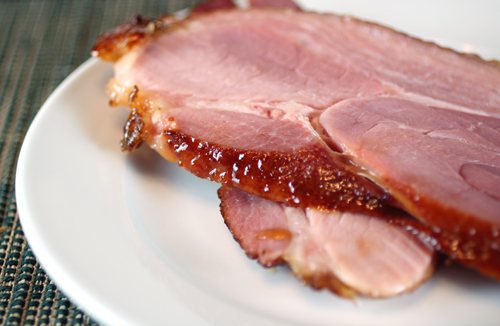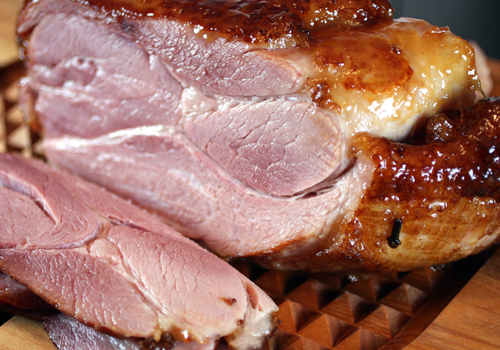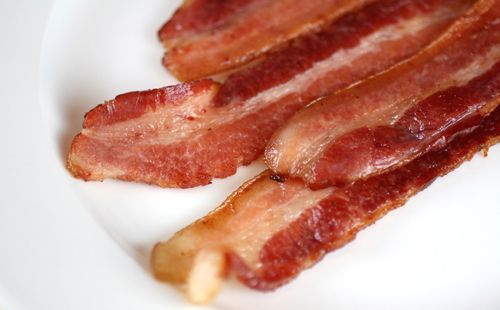Bruce Aidells On the Finer Points of Cured Pork

Less is more when it comes to curing pork and bacon.
Indeed, it’s what you don’t put into them that matters most, says Bay Area meat guru, Bruce Aidells.
It’s been years since Aidells has been associated with Aidells Sausage Company, which he founded and which still bears his name. But that doesn’t mean he hasn’t been busy with all things meaty. In fall 2010, the veteran cookbook author will publish a new comprehensive meat book that will include information on grass-fed beef, buffalo, goat, venison, sustainability, pasture-raised, and the importance of buying local.
Moreover, for the past three years, he’s been working with Vande Rose Farms in Iowa, helping its pig farmers cure bacon and ham, and find distributors for these artisan products. You’ll now find Vande Rose featured at restaurants such as BarBersQ in Napa, and sold at stores such as Andronico’s and Mollie Stone’s in the Bay Area, Central Market in Texas, and Balducci’s nationwide. The products also are available on the Vande Rose Farms Web site.
Aidells’ ham and bacon cure is essentially just salt, pepper, brown sugar, and nitrates. No water is added, which is key.
The term, “ham,” means no water added, he explains. In contrast, “ham with natural juices,” means that water has been added. So much so that after cooking, the latter will weigh 10 percent less than it did when you bought it.
“True ‘hams’ are very hard to find,” he says. “Not many people sell them, and not many people can tell the difference between them. But ‘hams’ are more expensive.”
It’s not hard to guess which type Aidells prefers.
“I don’t like the texture of water added,” he says. “I like the texture of meat.”

That’s just what you’ll find with Vande Rose Farms dry-cured hams, which have no water added. Aidells arranged for me to try a sample of the ham quarter (which normally sells for $45).
The hams come from Durocs, an artisan breed traditionally raised for bacon. Historically, there were two types of pigs, Aidells explains: lard pigs and bacon pigs. Berkshire — originally a British breed that became a sensation when the Brits gifted some of them to Japan, where they became known as Kurobuta — are so heavily marbled that they’re considered lard pigs. You can’t beat a Berkshire for a fine pork chop, Aidells says. But he thinks it has too much fat for making ham or bacon.
Duroc, originally from New Jersey but now found in parts of Europe, has much larger legs than a Berkshire, less marbling, and is considered a bacon pig.

For the past couple years, I’ve bought a Berkshire ham for my Christmas table. It has a thick layer of fat all around the leg. Spiral-cut, it comes out of the oven almost looking like bacon on the outside, with thick ripples of crispy fat all around. It’s a quite decadent way to celebrate the holidays.
But Duroc was new to me. This ham didn’t have that blanket of fat on the outside that the Berkshire does. It was quite meaty and dense, yet tender. It had a huge porky taste to it. It’s also on the salty side, so you’ll want the counterpoint of a sweet glaze to brush over it.
Aidells enjoys the Duroc ham in mac ‘n’ cheese, stuffing, crepes, with eggs, and in grilled cheese. It’s a ham that’s best served warm, he adds.
The Duroc bacon (12 ounces for $12.95) it striking in how incredibly substantial and meaty it is. If you’re used to bacon that’s mostly fat, this one will surprise you. It’s less salty than the ham. After one bite, I was thinking what a killer BLT it would make.
Aidells advises to cook the bacon slow over medium heat because of its high sugar content. Don’t make it too crispy, either, he says, or else you’ll mask the complex flavor.
If you have more hog-wild questions, you can ask Bruce, himself, 6 p.m.-8 p.m. Thursday, when he gives a talk all about pork and meat at the Tyler Florence Shop in Mill Valley, as reported on Tablehopper.com. Aidells will also sign copies of his previously published books, “The Complete Book of Pork” (William Morrow), and “The Complete Meat Book” (Houghton Mifflin). For more information, call the store at (415) 380-9200.


Oh man, I could go for a proper BLT right now.
Could Bruce arrange to send a ham here to Kuching?
I didn’t know he wasn’t associated with the company anymore. (love their chicken sausages) It’s great to hear the artisan products are available right here at our Central Market. As soon as I read that, I thought of Christmas dinner.
I wish I was having this for lunch!
Speaking from experience – I found a found a wholesale distributor that Bruce turned me on to and my AWESOME cousin got me 15 lbs of bacon and a half ham – and this stuff – well – it is simply amazing. Bruce is a great guy and turned me on to the fact of this new venture he was on – it is definitely worth a try!
Yummo! I’ve been very disappointed in the bacon I’ve been buying of late. This looks well-worth a try.
As always, Carolyn, you’ve got me drooling — most unseemly at this early hour of the day!
Nice article and very educational!
Very informative and its nice to keep up with someone who made such a difference in the food scene.
Cool…thanks for all of the info. The next time I am at Mollie Stone’s (a weekly occurance) I’ll pick up some of the Vande Rose ham or bacon. Maybe both! I do love a good blt this time of the year with slow roasted tomatoes on a good sourdough.
Of course I read this after I move out of the Bay Area. I love heritage pork – I may have to find a way to mail order some Duroc.
I love all things pork and cannot thank you enough for this post.
Mmmmmm….. I can just picture that ham in a baguette with some butter and avocado and the bacon looks perfect for a BLT!
That ham in mac & cheese would really be amazing. I thought nitrates are bad for you though?
Sophia: According to food scientist extraordinaire, Harold McGee, potassium nitrate is used to brighten meat color, improve flavor, and lengthen storage life. During curing, certain salt-tolerant bacteria transform a small portion of the nitrate into nitrite, which also helps retard rancid flavors in cured meat. Nitrate and nitrite can react with other food components to form possible cancer-causing nitrosamines, according to McGee’s book, “On Food and Cooking, the Science and Lore of the Kitchen.” The risk appears to be quite small, though. Still, it’s probably best to eat cured meats in moderation. In other words, don’t wolf down a BLT every day of the week. You should also know that nitrates occur naturally in some vegetables, such as celery. In fact, some charcuterie manufacturers use celery juice as a form of nitrates in their curing processes.
I have to try this.
By the way, where does one get berkshire pork?
Moe, I’ve found a very small amt of Kurobuta pork at the Nijiya markets, however it’s usually ground or in paper thin slices for shabu-shabu and not in nice big chunks. I had no idea that Berkshire was the same as Kurobuta. Would love to get my hands on a Berkshire ham for the holidays!
Fascinating article, as usual, Carolyn. I will have to pop by Mollie Stones’ meat dept. Had no idea that Aidells was no longer behind the Aidells sausages. Like Niman no longer part of Niman Ranch or Burt no longer part of Burt’s Bees, huh? hmmmm.
> Had no idea that Aidells was no longer behind the Aidells sausages. Like Niman no longer part of Niman Ranch or Burt no longer part of Burt’s Bees, huh? hmmmm.
Interesting point, Rena. Not uncommon in the high-tech world and understandable. The kind of person it takes to create a company is different from what it takes to run a large company and not many can make that change. Each of these people had the opportunity to sell the company — but their name had become part of the company brand.
Moe: Quite a few places mail-order Berkshire pork. Also, in the Bay Area, you can usually find it at Bi-Rite Market in San Francisco, and Whole Foods. Some of those more high-end grocery stores might also special order it for you if you ask them ahead of time.
Pingback: Food Gal » Blog Archiv » High on the Ham
Carolyn,
Your link to Vande Rose Farms is wrong. It goes to “Vande Rose foods” website available
Sally: Thanks for the head-up on that. I just fixed the link.